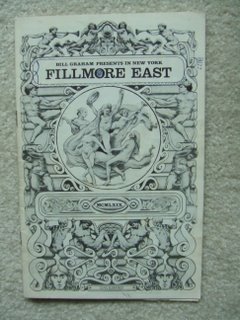Fillmore East

I'm so glad I saved some of these programs from the old Fillmore East. Bet you wish you were at this show! Check out the date at the bottom: June,1969. The Who were at or near the peak of their performing career. Keith Moon was still alive and Tommy had just been released. They put on an inspired, incendiary show. But the supporting acts were tremendous in their own right. It may be hard to fathom today, but Chuck Berry at one time was more than a perfunctory, self parodying oldies act. I recall him giving a vital, exciting performance. And Albert King, one of my favorites, was commanding and riveting. They weren’t in the least awed by opening for the Who.
They don’t put together shows like this anymore, do they?
 And you have to give at least some credit to Bill Graham—unreconstructed, unapologetic capitalist lout that he was— for these exceptional, genre-defying lineups. When I began writing this, my intention was to heap more scorn on the already vilified Graham. But after doing a bit of research I’ve reconsidered. (check out fillmore east history.html for Graham's letter announcing his closing of the Fillmores; it sounds almost idealistic compared to today's excessively commercial and corporate music scene).
And you have to give at least some credit to Bill Graham—unreconstructed, unapologetic capitalist lout that he was— for these exceptional, genre-defying lineups. When I began writing this, my intention was to heap more scorn on the already vilified Graham. But after doing a bit of research I’ve reconsidered. (check out fillmore east history.html for Graham's letter announcing his closing of the Fillmores; it sounds almost idealistic compared to today's excessively commercial and corporate music scene).Graham certainly was not simpatico with the hippie ethos. But he was not a rip-off artist either. He cared about the audience; he cared about the music. And he worked hard to produce exciting shows. I recall the shows at the Fillmore as being well run, and they were certainly incredible buys. You got 3 acts, the Joshua light show, and excellent seats in a moderately sized theatre.
But that’s not all. Flip through some of the Fillmore lineups and you come across all sorts of wildly inventive programming. Psychedelic rockers, obscure folk artists, sitar players from India, the occasional spoken word artist, jazz artists, blues players — Graham booked them all, often in surprising combinations. Today I suppose we would use the word “diverse”, to describe some of the Fillmore’s programming policies, but back then Graham was just reacting to the cultural Zeitgeist. In the “do your own thing” flower power decade the Fillmore audience was open to just about anything. And Graham was happy to oblige, and even push the boundaries. And he did a lot to open doors for black soul, blues and jazz artists, many of whom had been confined to the “chitlin circuit”. Putting Albert King with the Who? That had to be huge for Albert!
“He was out on the street checking tire treads to see if they’d picked up any nickels. I says, “Bill…” and he says, “Look, Neal, we’re in two different worlds. You’re a hippie and I’m a square. (p. 344 The Electric Cool Aid Acid Test)



0 Comments:
Post a Comment
<< Home